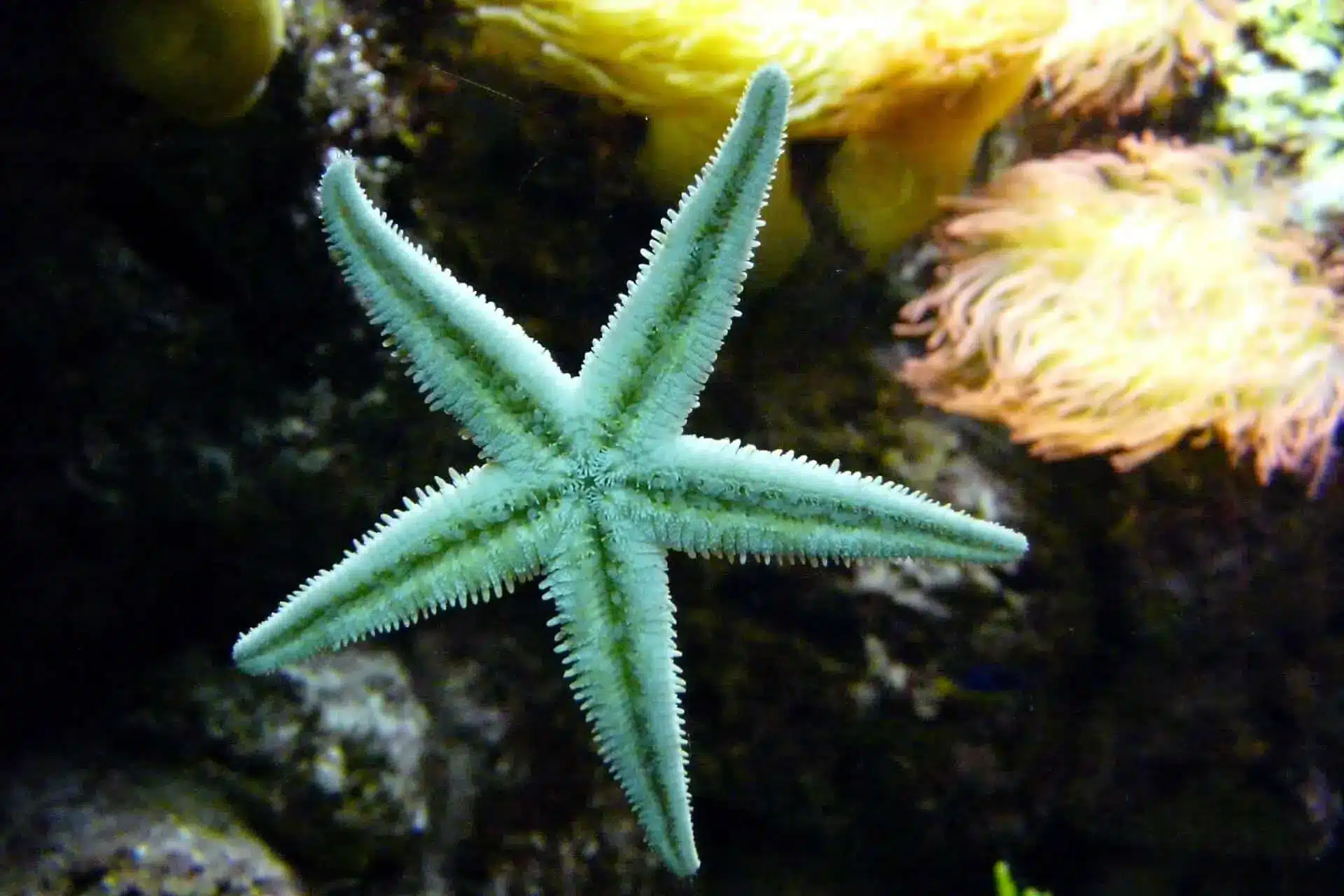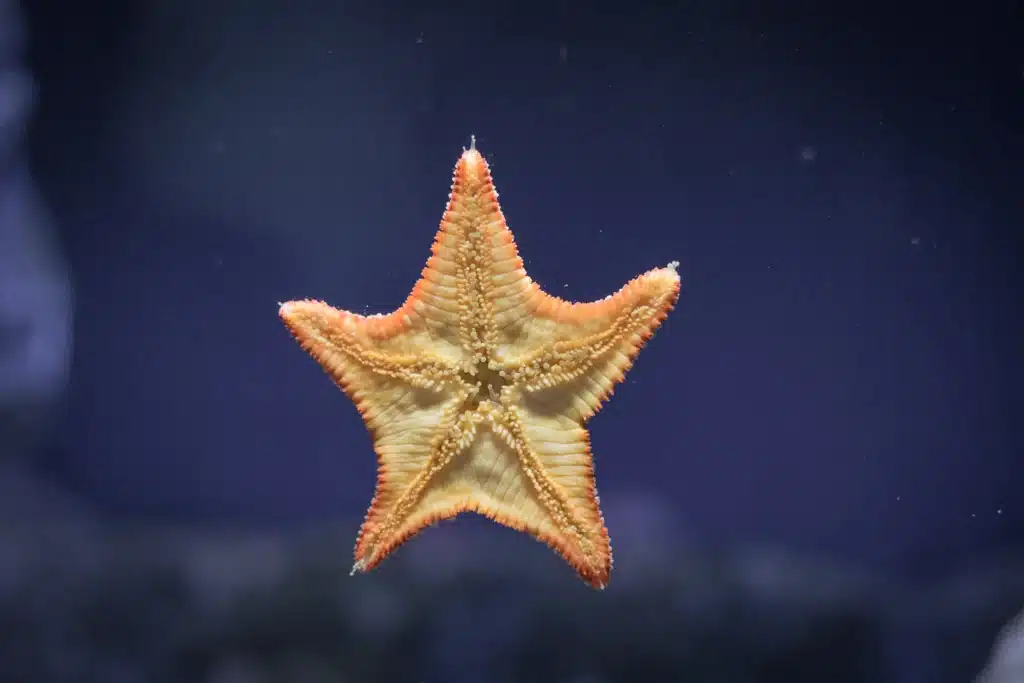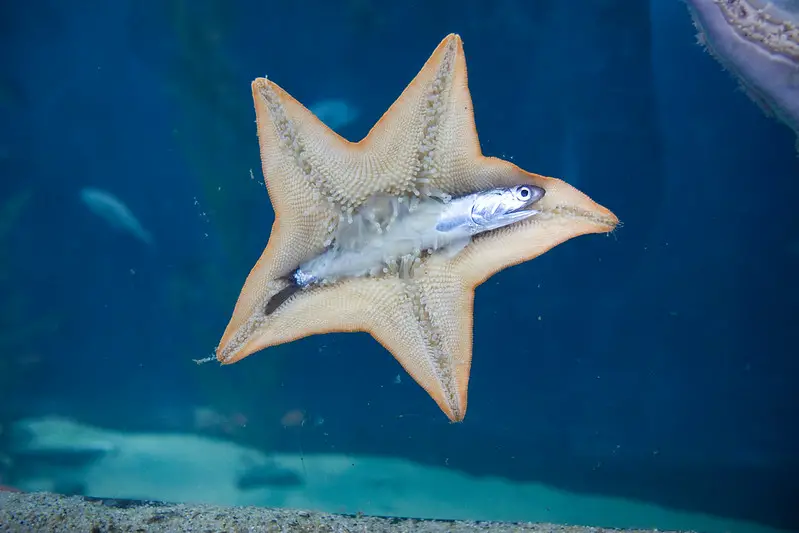How Do Starfish Feed

Introduction
How Do Starfish Feed: Starfish, known scientifically as echinoderms, are captivating marine creatures renowned for their distinctive appearance and intriguing feeding mechanisms. Although they may appear slow and unassuming, starfish have evolved remarkable strategies to capture and consume their prey in the vast depths of the ocean. This introductory exploration delves into the enigmatic world of starfish feeding, shedding light on the intricacies of their anatomy, behavior, and feeding habits.
At first glance, starfish seem quite different from conventional predators, lacking the typical features associated with hunting. Instead of sharp teeth or powerful jaws, starfish rely on an intricate hydraulic system and an array of specialized tube feet to engage in their unique feeding processes. These tube feet extend from the undersides of their arms and are equipped with tiny suction cups, allowing starfish to cling to rocks, shells, and prey with astonishing precision.
Starfish feed on a variety of marine organisms, including mussels, clams, snails, and even small fish. Their feeding methods can vary depending on the species and the type of prey, but they generally involve a combination of tube feet manipulation, stomach eversion, and enzymatic digestion. Starfish can exhibit both carnivorous and scavenging behaviors, showcasing their adaptability in the ever-changing underwater marine ecosystems.

What feeding type is a starfish?
Of the roughly 2,000 species of starfish, nearly all of them are carnivorous. This means they feed primarily on the flesh of other animals living in the ocean.
Starfish, or sea stars, exhibit a feeding type that can be described as a combination of scavenging and predation, making them fascinating and adaptable marine predators. Their feeding habits are primarily carnivorous, as they consume a variety of marine organisms such as mollusks (e.g., mussels, clams, and snails), small crustaceans, and even small fish. However, their feeding approach varies depending on the specific species of starfish and the availability of prey.
One of the most distinctive features of starfish is their array of tube feet located on the undersides of their arms. These tube feet are equipped with tiny suction cups that allow starfish to grasp onto rocks, shells, and their prey. When a starfish encounters potential food, it uses its tube feet to slowly and methodically maneuver its prey toward its central mouth located on the underside of its body.
In some cases, starfish can exhibit scavenging behavior, feeding on decaying organic matter and detritus on the ocean floor. This scavenging role is essential in marine ecosystems as it helps recycle nutrients and maintain a balanced ecosystem.
In essence, starfish are opportunistic feeders with a flexible feeding strategy that allows them to adapt to various food sources and ecological niches in the complex underwater world. This unique combination of scavenging and predation makes them a vital component of marine food webs.
How starfish captures and eats its prey?
Using tiny, suction-cupped tube feet, they pry open clams or oysters, and their sack-like cardiac stomach emerges from their mouth and oozes inside the shell. The stomach then envelops the prey to digest it, and finally withdraws back into the body.
Starfish employ a fascinating and unique set of mechanisms to capture and consume their prey, showcasing their adaptability and efficiency as marine predators. Here’s a detailed look at how starfish go about this process:
- Detection: Starfish do not have well-developed eyes, but they can sense their surroundings through light-sensitive cells on their skin. They often rely on chemical cues to locate potential prey, detecting the scent of nearby organisms or sensing the presence of food through their tube feet.
- Approach: Once a starfish detects prey, it uses its tube feet to slowly and methodically approach the target. The tube feet are equipped with tiny suction cups that enable the starfish to cling to rocks, shells, and the prey itself with remarkable precision.
- Capture: To capture prey like mollusks, starfish use their tube feet to pry open the shells of their victims. They exert steady pressure and gradually force the shells apart. Some larger species may also use their arms to hold the prey in place during this process.
- Stomach Eversion: One of the most astonishing aspects of starfish feeding is their ability to evert their stomach outside of their body. The starfish extends its stomach over the prey, enveloping it in digestive enzymes. This external digestion begins breaking down the prey’s tissues.
- Digestion: Once the prey is partially digested externally, the starfish begins absorbing the liquefied nutrients. The resulting soup of digested matter is then drawn back into the starfish’s body through its mouth.
How do starfish move and feed?
Grip and Pull Movement
Sea stars have a groove extending from the mouth into each arm. Along the groove there are 2-4 rows of small tubular projections called tube feet tipped with muscular suction cups. The tube feet are used for locomotion, feeding, respiration and sensory functions.
Starfish, fascinating marine creatures, employ a unique mechanism for both movement and feeding. Despite their seemingly simple structure, they possess a complex hydraulic system known as the water vascular system. This system is comprised of a network of canals filled with seawater, which serves multiple functions.
To move, a starfish uses hundreds of tiny tube feet located on its ventral surface. These feet extend through openings called podia and are operated by the water vascular system. By contracting and expanding these tube feet, the starfish creates a suction-cup-like effect, allowing it to grip surfaces and move in a slow but deliberate manner. This locomotion enables starfish to navigate various terrains, from rocky shores to sandy seabeds.
Feeding is another intriguing aspect of a starfish’s behavior. Their preferred diet primarily consists of bivalve mollusks, such as clams and mussels. Using their tube feet, starfish pry open the shells of their prey. Once the shell is slightly ajar, the starfish everts its stomach out through its mouth and into the prey’s shell. There, it releases digestive enzymes, which break down the soft tissues of the mollusk into a semi-liquid form. This nutrient-rich soup is then absorbed back into the starfish’s stomach.
How do starfish feed themselves?
A starfish feeds by first extending its stomach out of its mouth and over the digestible parts of its prey, such as mussels and clams. The prey tissue is partially digested externally before the soup-like “chowder” produced is drawn back into its 10 digestive glands.
Starfish employ a distinctive feeding mechanism that showcases their remarkable adaptation to marine environments. Their preferred diet mainly consists of bivalve mollusks like clams and mussels. To feed, starfish utilize their tube feet, a crucial part of their water vascular system.
First, a starfish uses its tube feet to firmly grip the shell of its prey. With slow and deliberate movements, it exerts pressure on the shell, gradually prying it open. Once a small gap is created, the starfish then everts its stomach out through its mouth and into the shell of the prey. This might sound extraordinary, but it’s a fundamental aspect of their feeding process.
Inside the shell, the starfish releases digestive enzymes. These enzymes serve to break down the soft tissues of the mollusk into a semi-liquid form. This nutrient-rich “soup” is then absorbed back into the starfish’s stomach. This efficient method of external digestion allows starfish to consume prey larger than their own mouth, making them formidable hunters in their underwater habitats.
How do starfish eat their food?
The starfish forces open the shell with suction disks on the underside of its body, and then inserts its stomach membranes through its mouth into the opening of the shell. Digestive juices break down the shellfish’s body, which is then absorbed into the starfish’s stomach.
Starfish exhibit a remarkable feeding process that distinguishes them in the marine world. Their primary diet comprises bivalve mollusks such as clams and mussels. To consume their prey, starfish rely on a combination of tube feet and a unique method of digestion.
Using their numerous tube feet, starfish secure a firm grip on the shell of their chosen prey. Through a slow and steady application of pressure, they gradually pry open the shell. Once a gap is established, the starfish astonishingly everts its stomach out through its mouth and into the shell of the prey.
Inside the shell, the starfish releases potent digestive enzymes. These enzymes serve the crucial function of breaking down the soft tissues of the mollusk into a semi-liquid state. This rich mixture of nutrients is then absorbed back into the starfish’s stomach. This method of external digestion allows starfish to consume prey larger than their own mouths, showcasing their adaptability as predators in diverse marine habitats.
How do starfish eat?
Starfish are carnivorous and use a unique feeding method. They typically feed on mollusks like clams and oysters. They extend their stomachs out of their mouths and into the shells of their prey.
Starfish have a fascinating and unconventional method of feeding. Their diet primarily consists of bivalve mollusks like clams and mussels. To consume their prey, starfish utilize a combination of specialized structures and a unique digestive process.
Using their numerous tube feet, starfish grip the shell of their chosen prey. Through a slow and steady application of pressure, they gradually pry open the shell. Once a gap is created, the starfish incredibly everts its stomach out through its mouth and into the shell of the prey.
Inside the shell, the starfish releases potent digestive enzymes. These enzymes serve the critical function of breaking down the soft tissues of the mollusk into a semi-liquid form. This nutrient-rich mixture is then absorbed back into the starfish’s stomach. This method of external digestion allows starfish to consume prey larger than their own mouths, showcasing their adaptability as predators in diverse marine habitats.
This feeding strategy is a testament to the ingenuity of nature’s designs, enabling starfish to thrive and fulfill important ecological roles in marine ecosystems worldwide. It exemplifies how organisms evolve unique strategies to exploit available resources and contribute to the complex web of life in the oceans.
Can starfish eat prey larger than their mouths?
Starfish, also known as sea stars, are fascinating marine creatures renowned for their ability to regenerate lost limbs and their unique method of feeding. However, when it comes to their diet, starfish are somewhat limited by the size of their mouths. Typically, a starfish’s mouth is located on its underside, surrounded by a ring of flexible tube feet that help it capture and manipulate its prey.
While starfish are opportunistic predators, they do have a size constraint when it comes to their prey. Their mouths are not designed to accommodate prey larger than their own body size. Instead, they primarily feed on smaller marine animals such as mollusks, crustaceans, and even smaller fish. They use their tube feet to grasp and immobilize their prey, and then they evert their stomach out of their body to partially digest and absorb the soft tissues of their catch.
In cases where a starfish encounters prey larger than its mouth, it faces a challenge. It must rely on the slow process of digestion through its extended stomach. This means that while starfish are skilled hunters, their size and anatomy limit them to prey that can fit within their mouth and be processed over time.
Do all species of starfish feed in the same way?
Starfish, or sea stars, are a diverse group of marine animals, and their feeding methods can vary among different species. While the basic mechanism of using tube feet and an everted stomach to capture and digest prey is common to most starfish, there are variations in their feeding strategies and preferences.
Some species of starfish are generalist feeders, meaning they consume a wide range of prey, including mollusks, crustaceans, and detritus (dead organic matter). These starfish tend to have a broader diet and can adapt to different food sources based on availability.
On the other hand, there are specialized starfish species that have evolved to feed on specific types of prey. For example, the crown-of-thorns starfish primarily feeds on coral polyps, posing a significant threat to coral reefs. Sunflower starfish are known for their preference for sea urchins, which they capture and consume with their numerous tube feet.
So, while the fundamental feeding mechanism is similar among starfish, their specific diets and feeding behaviors can vary widely depending on their species and ecological niches. This diversity in feeding strategies allows starfish to occupy various roles in marine ecosystems, from herbivores to carnivores and scavengers.

Conclusion
In the depths of the ocean, starfish exemplify nature’s ingenious adaptability in the realm of feeding. Their seemingly unassuming appearance conceals a remarkable set of tools and strategies that enable them to thrive in diverse marine ecosystems.
First and foremost, starfish showcase the beauty of nature’s diversity. Their feeding methods, which range from sophisticated tube feet manipulation to stomach eversion, demonstrate the versatility of life under the sea. Whether scavenging for decaying matter or actively hunting for live prey, starfish exhibit a dynamic approach to survival.
Starfish are a testament to the interconnectedness of marine ecosystems. As they feed on various organisms, they play an essential role in regulating populations and maintaining ecological balance. Their presence can shape the abundance and distribution of species on the ocean floor.
These captivating creatures, with their unique adaptations and feeding strategies, remind us of the endless wonders and mysteries of the natural world. They inspire us to continue exploring, appreciating, and conserving the fragile ecosystems that make our planet so extraordinary.



